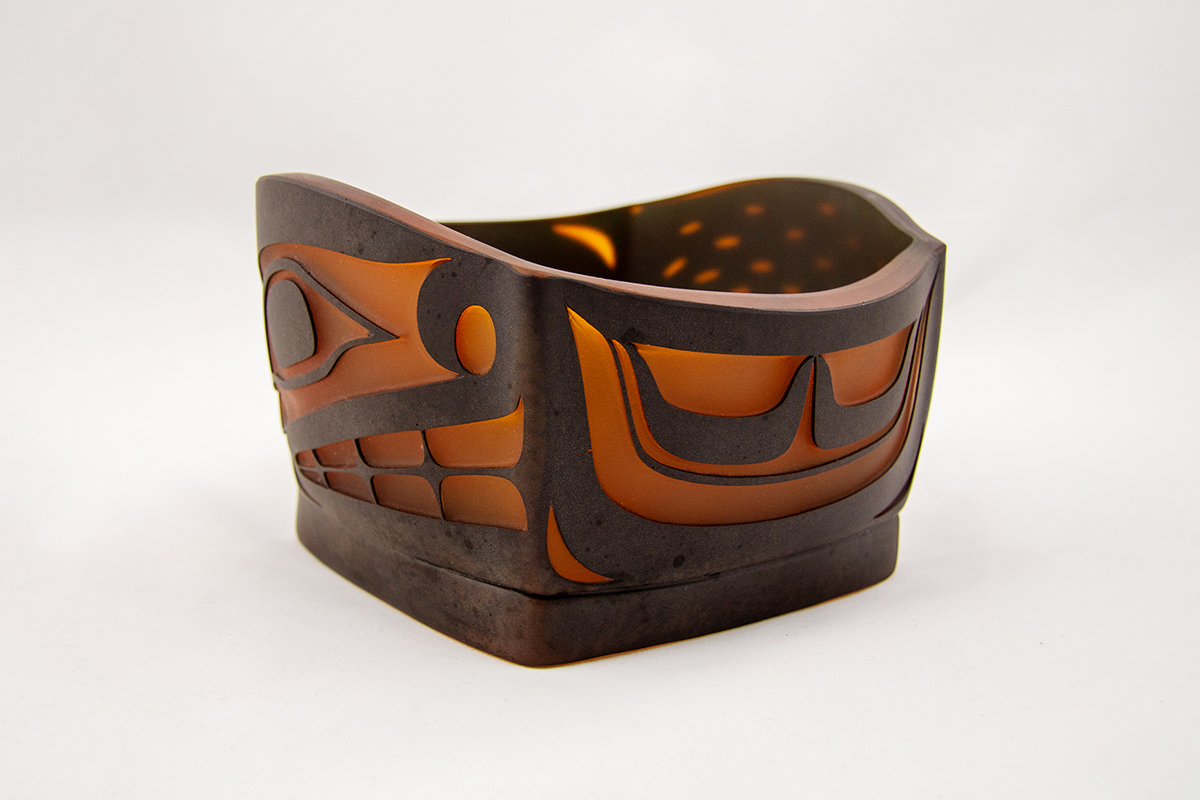
Krannert Art Museum has acquired a number of works of art by contemporary Native American artists, including this glass piece by Preston Singletary, a Pacific Northwest artist.
Preston Singletary (Tlingit, San Francisco, California, United States; b. 1963), Wolf Grease Dish, 2013. Blown and sand-carved glass. Gift of Len Lewicki. 2020-13-2. © Preston Singletary
Courtesy Krannert Art Museum
CHAMPAIGN, Ill. — Krannert Art Museum has recently acquired a number of works of art by modern and contemporary Native American artists – painting, glasswork and pottery – that will help the museum better present the history of Native American art and the broader history of modern and contemporary art.
KAM has been working steadily over the past decade to increase the presence of women artists, Native American artists and artists of color in the collection, which historically has disproportionately represented the work of white men, KAM director Jon Seydl said.
"We've been working to redress these historical imbalances in a number of ways," including collaborative initiatives with Native American House and American Indian Studies to engage with and promote the creative contributions of Native Americans, he said.
As part of a land-grant university, the museum has a particular responsibility to present work by the people who originally inhabited the land, drawing attention to both historical and contemporary voices, Seydl said.
"Over the last few years, there has been renewed attention to the work of contemporary Native artists, not only at KAM but across campus. There's a flowering of interest both at Illinois and in the region. This is important and special, and it's great to be a part of it," Seydl said.

"Loss" by Kay WalkingStick is currently on view at Krannert Art Museum.
Kay WalkingStick (Cherokee, Syracuse, New York, United States; b. 1935), Loss, 1989. Oil on canvas. Museum purchase through the John N. Chester Estate Fund and the Richard M. and Rosann Gelvin Noel Krannert Art Museum Fund. 2020-12-2 © Kay WalkingStick
Courtesy Krannert Art Museum
KAM used an award from the John N. Chester Estate Fund and the Richard M. and Rosann Gelvin Noel acquisition fund to buy "Loss," a 1989 painting by Kay WalkingStick. A member of the Cherokee Nation and art professor emeritus at Cornell University, WalkingStick is "one of most celebrated senior Native American artists living today," said senior curator Allyson Purpura. A 40-year retrospective of her work appeared in 2015-16 at the Smithsonian National Museum of the American Indian. "Loss" is currently on view in KAM's installation of the modern and contemporary art collection "Art Since 1948."
WalkingStick is known for her diptychs – two-paneled works that pair abstract, geometric forms on one side with brightly colored landscapes on the other. She paints predominately with her hands to thickly layer a mixture of saponified wax and acrylic paint. "Loss" features a wooden panel with a translucent red band beneath a silver quarter-circle. Its thick, waxy surface seems to ripple like the water's surface, with light glinting in its crests and troughs, Purpura said. It is paired with a canvas on which a waterfall is painted in dark blacks, grays and whites.
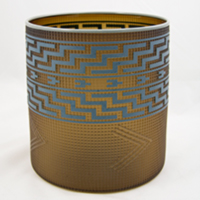
Preston Singletary (Tlingit, San Francisco, California, United States; b. 1963), Basket, 2013. Blown and sand-carved glass. Gift of Len Lewicki. 2020-13-3. © Preston Singletary
Courtesy Krannert Art Museum
The painting is part of WalkingStick's "Cascade" series of six diptychs created in response to the sudden death of her husband.
"WalkingStick is interested in the dialogue between the ephemeral and enduring, the spiritual and material," Purpura said. "In the series, she pairs these very minimalist geometric motifs with images of the raging waterfalls and churning eddies that surround the Cornell campus. 'Loss' is a very powerful, very fraught work. It's a deeply important work to her, emotionally and personally."
KAM also acquired three glass works by Preston Singletary, a Pacific Northwest artist known for using traditional Tlingit motifs and narratives in the nontraditional medium of glass.
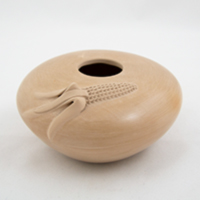
Iris Youvella Nampeyo (Hopi-Tewa, HopiPueblo, Arizona, United States; 1944-2018), Buff-colored Seed Jar with Corn Design in Relief, late 20th century. Ceramic. George Ogura Collection, Gift of Shozo Sato and Mrs. Alice Ogura Sato for the late Dr. George I. Ogura. 2020-8-5 ©Iris Youvella Nampeyo
Courtesy Krannert Art Museum
"KAM has a really great contemporary glass collection, but we had no work by Singletary," Seydl said. "Singletary is one of the most important artists working in glass today. These objects help tell a more representative story with our glass holdings, and they will energize the galleries with their striking forms and ideas."
Singletary has a bold, graphic style, and in the three pieces donated to KAM by U. of I. alumnus Len Lewicki, the artist combines light glass with dark patterning.
"Ghost Faced Ladle" is a large yellow and black spoon whose handle and overall shape suggests a loon. "Wolf Grease Dish" is an amber and black vessel resembling a Tlingit dish used for collecting fish oil. "Basket" is a beige-green glass version of a Tlingit basket customarily woven from spruce tree roots.
"Some artists are just taking a historical form and rendering it in glass, but Singletary is transforming the work by rethinking both the traditions of his Tlingit background and the Pacific Northwest glass culture he trained in," Seydl said.
Singletary's works are on view in KAM's Moore Gallery of Decorative Arts and in a study case next to its auditorium.
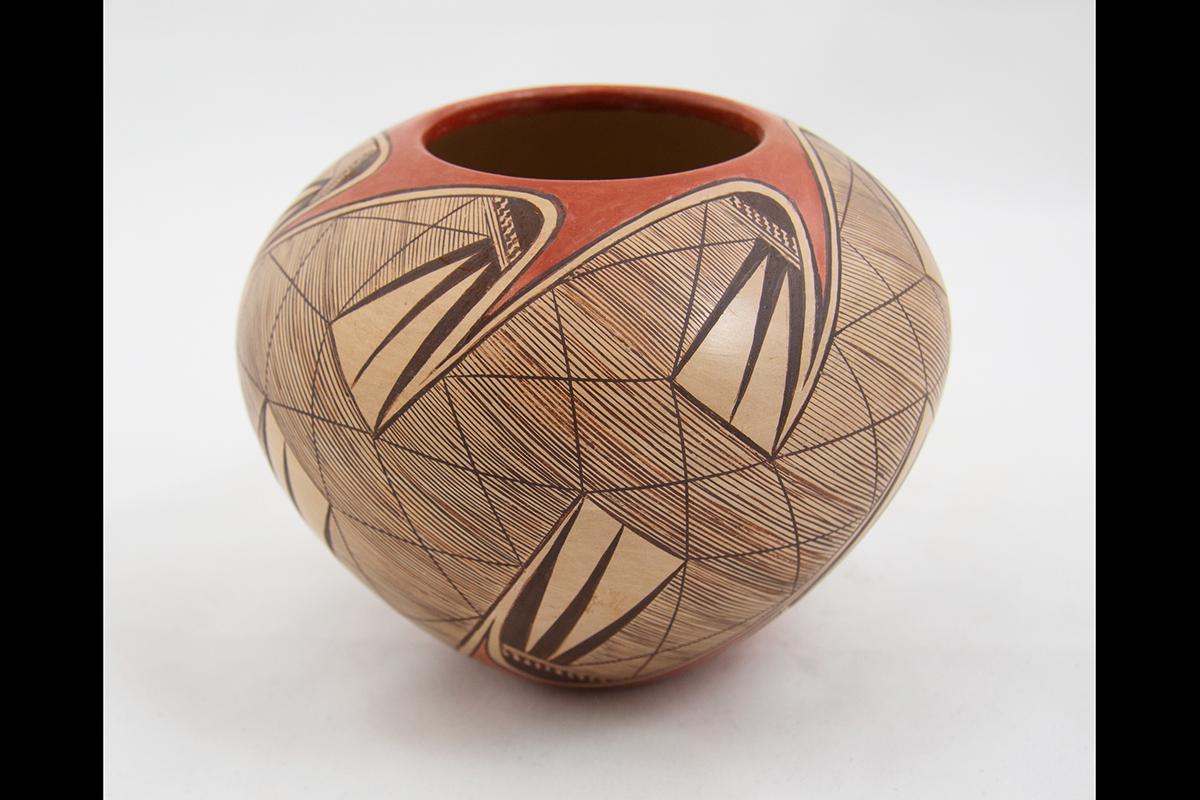
Examples of pottery by a renowned Hopi-Tewa pottery lineage feature "migration patterns" -- abstracted feathers, wings, waves and crosshatching -- that refer to Hopi stories about their ancestors emerging from the depths of the earth to the present-day Hopi Nation.
Dextra Quotskuyva Nampeyo (Hopi-Tewa, Hopi Pueblo, Arizona, United States; 1928-2019), Polychrome Jar with Migration Patterns, mid 20th century. Ceramic. George Ogura Collection, Gift of Shozo Sato and Mrs. Alice Ogura Sato for the late Dr. George I. Ogura. 2020-8-9 © Dextra Quotskuyva Nampeyo
Courtesy Krannert Art Museum
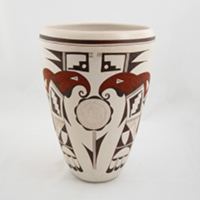
Joy Navasie (Hopi-Tewa, Hopi Pueblo, Arizona, United States; 1919-2012), Polychrome Whiteware, mid to late 20th century. Ceramic. George Ogura Collection, Gift of Shozo Sato and Mrs. Alice Ogura Sato for the late Dr. George I. Ogura. 2020-8-18 © Joy Navasie
Courtesy Krannert Art Museum
A collection of almost 100 examples of Pueblo pottery – ceramic vessels, miniature vessels and storyteller figurines – was donated to KAM by the late George I. Ogura in 2020. Most of the vessels in the Ogura gift were made by women potters active between the 1930s and 1980s, many coming from renowned pottery lineages that include multiple generations of artists, Purpura said.
"With this bequest, we have exemplary representations of some of the most well-known lineages," Purpura said. "That's exciting. We can see how women both drew on the motifs and designs and forms of their mothers and aunts and ancestors, but also improvised and developed their own unique hand."
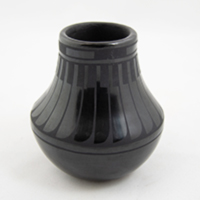
Blue Corn (San Ildefonso, San Ildefonso Pueblo, New Mexico, United States, 1921-1999), Blackware jar, mid to late 20th century. Ceramic. George Ogura Collection, Gift of Shozo Sato and Mrs. Alice Ogura Sato for the late Dr. George I. Ogura. 2020-8-27 © Blue Corn
Courtesy Krannert Art Museum
The artists include family members of one of the most famous Hopi-Tewa potters, Nampeyo of Hano (1860-1942), who reinterpreted motifs from historical Sikyatki culture, in what is known as Sikyatki Revival style.
Her daughter, granddaughter and great-granddaughter developed their own styles that incorporated the design legacy of Nampeyo, which featured abstracted feathers, wings, waves and crosshatching. These motifs became known as "migration patterns" that refer to Hopi stories about their ancestors emerging from the depths of the earth to make their homes on the three mesas of the present-day Hopi Nation, Purpura said.
The range of the newly acquired vessels and miniatures will greatly expand KAM's current collection of Pueblo pottery, which includes three vessels dating to the 1800s and one vessel from the late 1700s, Purpura said. She is organizing a February 2022 exhibition at KAM to showcase the pottery.






